Price-based Demand Response Supported Three-stage Hierarchically Coordinated Voltage Control for Microgrids
IF 5.7
1区 工程技术
Q1 ENGINEERING, ELECTRICAL & ELECTRONIC
Journal of Modern Power Systems and Clean Energy
Pub Date : 2024-06-25
DOI:10.35833/MPCE.2024.000263
引用次数: 0
Abstract
Photovoltaic (PV) inverter, as a promising voltage/var control (VVC) resource, can supply flexible reactive power to reduce microgrid power loss and regulate bus voltage. Mean-while, active power plays a significant role in microgrid voltage profile. Price-based demand response (PBDR) can shift load demand via determining time-varying prices, which can be regarded as an effective means for active power shifting. However, due to the different characteristics, PBDR and inverter-based VVC lack systematic coordination. Thus, this paper proposes a PBDR-supported three-stage hierarchically coordinated voltage control method, including day-ahead PBDR price scheduling, hour-ahead reactive power dispatch of PV inverters, and real-time local droop control of PV inverters. Considering their mutual influence, a stochastic optimization method is utilized to centrally or hierarchically coordinate adjacent two stages. To solve the bilinear constraints of droop control function, the problem is reformulated into a second-order cone programming relaxation model. Then, the concave constraints are convexified, forming a penalty convex-concave model for feasible solution recovery. Lastly, a convex-concave procedure-based solution algorithm is proposed to iteratively solve the penalty model. The proposed method is tested on 33-bus and IEEE 123-bus distribution networks and compared with other methods. The results verify the high efficiency of the proposed method to achieve power loss reduction and voltage regulation.求助全文
约1分钟内获得全文
求助全文
来源期刊

Journal of Modern Power Systems and Clean Energy
ENGINEERING, ELECTRICAL & ELECTRONIC-
CiteScore
12.30
自引率
14.30%
发文量
97
审稿时长
13 weeks
期刊介绍:
Journal of Modern Power Systems and Clean Energy (MPCE), commencing from June, 2013, is a newly established, peer-reviewed and quarterly published journal in English. It is the first international power engineering journal originated in mainland China. MPCE publishes original papers, short letters and review articles in the field of modern power systems with focus on smart grid technology and renewable energy integration, etc.
 求助内容:
求助内容: 应助结果提醒方式:
应助结果提醒方式:


